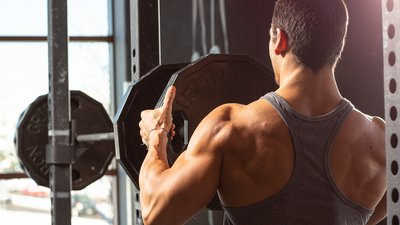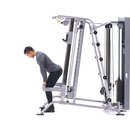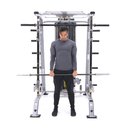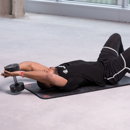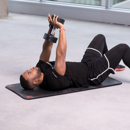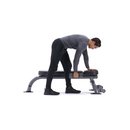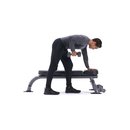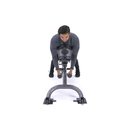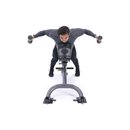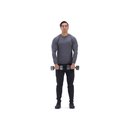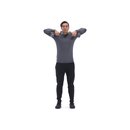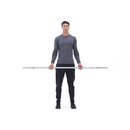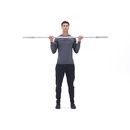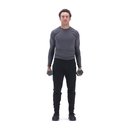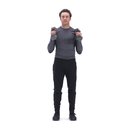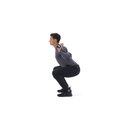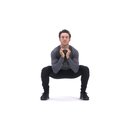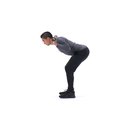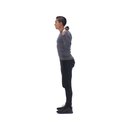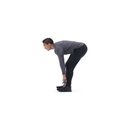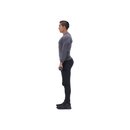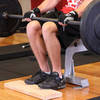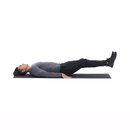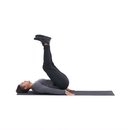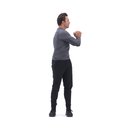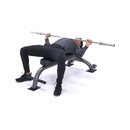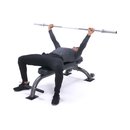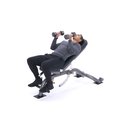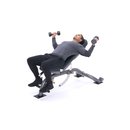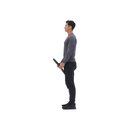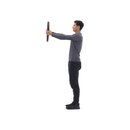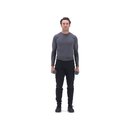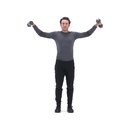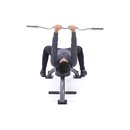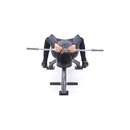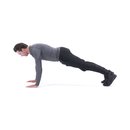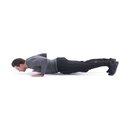Part 1 | Part 2
Home workout equipment is a billion-dollar industry, filled with consumers who buy the latest as-seen-on-tv gadget, use it for two weeks, and then add it to their growing collection of useless crap under the stairs. This collection, of course, is hidden behind an old Gazelle Fitness Flyer masquerading as a coat rack.
This article is for people like me: people who want their own space to get bigger, better and stronger, people who can't stand fancy commercial gyms which ban chalk, good music and any type of training that might be considered useful. Ultimately, this is for people who love training, whether it's for bodybuilding, powerlifting or sport.
If this sounds like you, you might be the perfect candidate for your own home gym. That is, if you have the dedication, a small investment of cash for gym equipment, and space can help you hit your goals. Divert dollars from your extra vehicle and invest in something you'll use every day. Invest in your own gym.
I'm here to review the vital equipment, help you set up, and offer important safety tips.
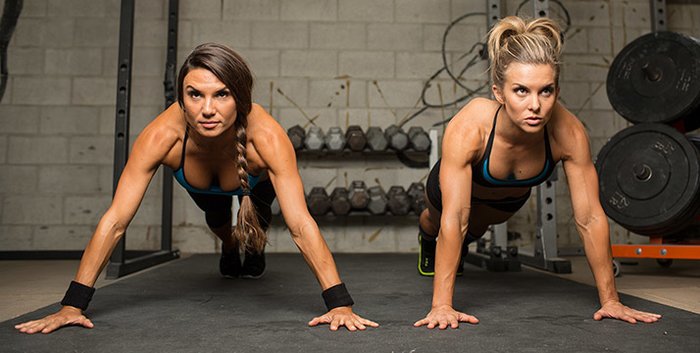
"If you have the dedication, a small investment of cash and space can help you hit your goals."
Atmosphere Is Everything
Before we even touch equipment, visualize and choose your space. Ideally, you'll have free reign to affect your gym's look, feel, and sound. My training space is a two-car garage. The walls are painted, posters are up, the speakers are loud, and it's basically built to keep me motivated.
Important note: I haven't spent a lot of money building my sick training sphere. In this game, money isn't king. I've made certain training tools myself. Others I've found on Craigslist, paying pennies on the dollar. I've borrowed from friends and family. I'm diligent about hunting for sales and used items at sports stores.
Only rarely do I pay full price for something if I can find it or build it cheaper. It's important to have patience. A gym is something you can build over time, starting with the essentials.
Once you establish your space and budget, you can begin to build. I recommend starting with the following five essential pieces of equipment.
1. Barbell And Weights
While it's the most important, a barbell is usually easy to find. There are two main barbell types: standard and Olympic. Standard bars are one inch in diameter, with 1-inch holes through the plates. They're fair for light applications but aren't suitable for heavy lifting. The bars bend easily and usually can't hold more than 200 pounds.
Olympic bars are typically 7 feet long with a rotating, 2-inch-diameter sleeve. These bars are made for heavy weight and big, ugly, compound lifts. They're beautiful.
As for weight plates, you can find them almost anywhere. New "in-store" costs are typically $1 per pound. Search flea markets, the classifieds, and check with friends or family: You can easily find used plates for less than 50 cents per pound.
Sales are also helpful. I was able to find about 900 pounds new for $180 at an after-Christmas sale. Three-hundred-pound barbell sets that normally run $200 were on clearance for $60. They had three left; I bought them all.
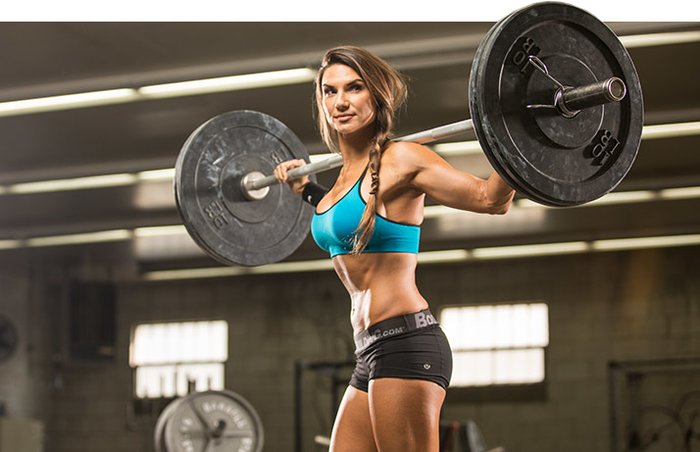
"While it's the most important, a barbell is usually easy to find."
The bar is arguably the most important piece of equipment in your gym. Most barbell sets come with an inexpensive Olympic bar, usually chrome plated and rated for approximately 400 lbs. These are fine for beginners and a good place to start, but in time the sleeves will fall off and the bar will probably bend.
If you're fairly advanced and strong, I wouldn't recommend using such a bar for heavy lifts. A good bar is difficult to damage and is 100% worth a little extra cash. If you take care of them, there are many good bars in the $150-300 range that will last indefinitely.
To set up my garage gym, I had three "beater bars" that came with my holiday weight sets. I quickly damaged all three: two bent during squatting, and one had the sleeves come off during cleans. Fortunately, on Craigslist, I found a $60 Power Bar rated for 1,500 pounds. I also invested some money into a Pendlay HD Nexgen bar, about $300. This bar was designed for Olympic lifting, has a lifetime warranty on it, and is tested to 2,500 pounds!
2. Rack Up Your Gains
A power rack is the centerpiece of a home gym. Nearly anything important can be done within one, and they add a considerable measure of safety. The pins will save you if you miss a lift, and the J-hooks allow you to perform nearly any free weight move. Many racks have attachments such as dip and pull-up bars to increase their functionality.
One objection to a rack I frequently hear is that it takes up too much space. If you have room for a 7-foot bar and a bench, then you have room for a rack. If you need a little extra clearance, donate the wife's old wardrobe. It's for a good cause.
You can find new racks on the low end for less than $500. For most users, these will be just fine. My first rack was from Powertec, and it was home to many lifts greater than 600 pounds.
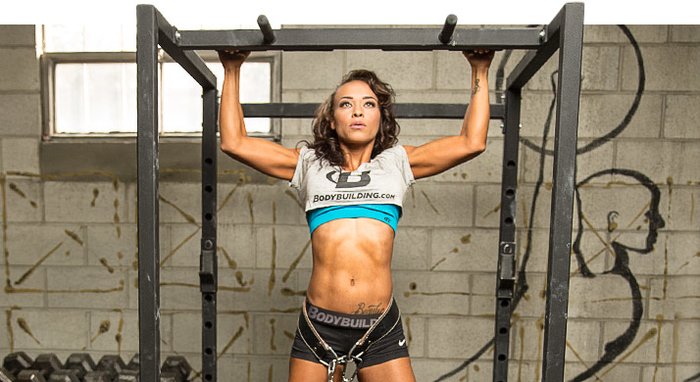
"A power rack is the centerpiece of a home gym."
Like cars, there are a wide variety of racks with various add-on options. Check out the Forums to browse reviews and get an idea of what you might want.
Some things to consider on your power rack:
Hole Spacing: Spacing can vary from 1-4 inches. To understand why this matters, imagine bench pressing and then failing on your last rep, getting pinned by the weight. 1-2 inch hole spacing allows you to complete a full range of motion in your press without hitting the pins, while still giving you the option to dump the weight in an emergency. 4-inch hole spacing could mean that the pins are either too high (limiting your range of motion) or too low (you can't dump the weight).
Strength: Consider your abilities versus what the rack is made to handle. Are the joints welded or bolted? How strong are the pins? They should be at least 1-inch thick and able to hold more than 1,000 pounds with no problem. Can the rack tip or must it be bolted to the floor?
Accessories: Racks can come with pull-up/chin bars, dip attachments, band pegs, even pulley systems for a complete home gym set up.
Dimensions: If you've been around a few racks (wink, wink), there are a few things to notice regarding dimensions. One is depth. Short racks take up little space, but allow little movement within.
Width is also an issue. Generally, racks will be 46-50 inches on the inside dimension. If they are too wide, you may have a problem hitting the uprights when racking weight. If the rack is too narrow, you may not be able to get your feet wide enough for certain lifts. Know what you want.
Additionally, consider height. If you have limited room to play with, shorter racks are available. Alternately, if you wish to be able to do a standing press over your head, you will need either a very tall or open rack.
As with any equipment, look for deals and used items in your area. Like your bar, the rack is an investment. Racks are durable and customizable, and a little extra money goes a long way.
My training partner and I built my current rack by hand. It weighs approximately 400 pounds. We bought that much steel from a junk yard for $50. I had a friend help me weld it to the dimensions I desired. We added band pegs on the bottom and installed a 300-pound weight stack in the back. The weight stack came free from a company that had a piece of broken equipment. I also added chain safeties and a pull-up bar. My total cost, so far, is roughly $200.
3. Bench It, Kid
Certain movements require you to lie down, such as a bench press. This is an area where I'd definitely shop around. You can probably find something decent if you're diligent.
Again, pay attention to what you need. Most of the benches in circulation are meant to support a couple hundred pounds. If you're a serious lifter, you might load 600 pounds on your bench (including your body weight), so you'll want to avoid the cheap MegaMart benches.
Again, watch for gym auctions, sales, classifieds, etc. If you can't find anything used, many new benches are reasonably priced. Ensure that the bench is the correct height for you by lying on it and placing your feet flat on the floor. You should be able to drive through your feet. I would also recommend getting an adjustable bench.
What if you can't get a bench right away? No problem. Many of the exercises you might do on the bench can be done on the floor (a floor press, for example), or you can build your own strong and inexpensive bench. A couple scrap pieces of lumber and some cinder blocks can hold a house. They'll work well for a makeshift bench.
4. Dumbbells
With dumbbells, you've got a wide variety of options at numerous price points. Dumbbells are just as versatile as barbells (or more), although you can't load resistance the way you can with a bar. The most economical dumbbells will be plate-loadable dumbbells. They come in both Olympic or Standard, which makes it easy to match your barbell plates. (Make sure you have enough "change" weight, of course. Extra 2.5 and 5 pound plates are helpful.)
If you're on a budget, I recommend opting for standard handles. These small weights are the most common at garage sales and buried in people's closets. I've been able to collect more than 200 pounds of dumbbell weight at almost zero cost this way.
Your next option is selectable dumbbells, such as those made by Bowflex and PowerBlock. These are usually expensive and not nearly as durable as the cast iron and steel mentioned above. However, they are a good option for those limited in space. Typically, it will be hard to find these in heavier sizes.
Your final option, if you have both the money and the space, is to set up a commercial-style dumbbell rack. While this is awesome, it will cost hundreds or thousands of dollars and take up far more space than the $100 plate-load system. Fixed dumbbells are also more comfortable and considered safer by some.
You'll have to weigh the costs and benefits on this one.
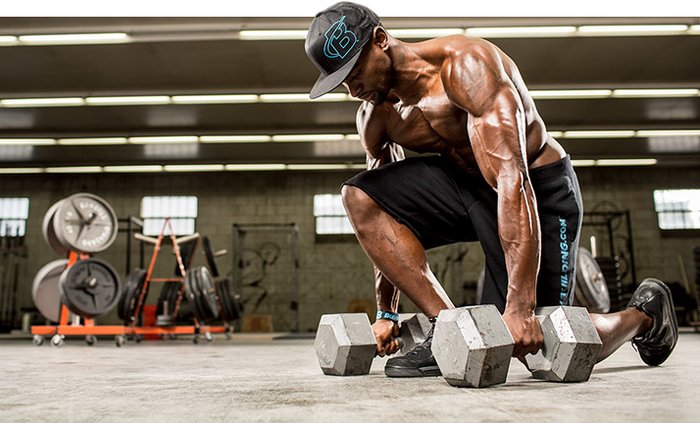
"With dumbbells, you've got a wide variety of options at numerous price points"
5. Your Power-Up Platform
A simple platform can be a great blessing. It will protect your equipment and your floors, and will deaden much of the sound caused by clanging weights. If you perform deadlifts or Olympic movements, you should definitely put down a platform. Otherwise, you can easily crack concrete, even through a rubber mat.
Platforms generally consist of a couple sheets of plywood with a top made of rubber, or rubber and hardwood. They typically cost hundreds of dollars, but you can easily make one for far less than that. Generally, platforms are 8x8, though you can make them to any size. Here's how:
First, find the rubber. I chose 3/4-inch-thick horse-stall mats from a Western supply store. You will only need one sheet, typically around $40, if you're going to use a wood insert on the top. If you want your platform to be completely rubber, get two sheets.
Here's the hitch: while you can cut everything to size, my stall mats were only 4x6 (as opposed to 4x8). Side by side, two mats would be 8x6. Since 6 feet is plenty of room, I decided to skip the headache of trying to fit my mats into an 8x8 area and built an 8x6 platform instead.
Next, depending on the size of your platform, you'll need 2-4 sheets of plywood. For mine, I used three sheets and cut one of them in half. I laid them lengthwise on the ground so I had two 8x6 layers of plywood. Then I put the rubber across the plywood.
If you want a wood insert on top, cut your single piece of rubber into sections that are 2-feet wide. These will be placed on the edges of the platform, where the weights will strike. Then you will place a piece of 4-foot hardwood between the rubber sections.
Next, screw everything down or it will move as time lapses. As with your rack, you have multiple options with your platform. Your rack can even be bolted down into it (saving you from bolting a rack directly into the floor). I installed band attachments on mine, which do double service since they hold the platform together. Regardless of how you set it up or even if you buy one outright, I consider the platform to be a must-have for a complete home gym.
Lift Heavy, My Friends
With these five essentials, you're ready to begin your home gym domination.
Stand on your platform and shout. This is your space. You've got your own gym, your own equipment and your own plates.
Lift them wisely.
Here’s a three-day workout split to get you huge in your home gym:

